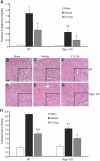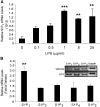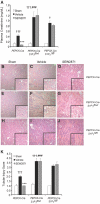Activation of sphingosine-1-phosphate 1 receptor in the proximal tubule protects against ischemia-reperfusion injury
- PMID: 20338995
- PMCID: PMC2900956
- DOI: 10.1681/ASN.2009060662
Activation of sphingosine-1-phosphate 1 receptor in the proximal tubule protects against ischemia-reperfusion injury
Abstract
Agonists of the sphingosine-1-phosphate receptor (S1PR) attenuate kidney ischemia-reperfusion injury (IRI). Previous studies suggested that S1P1R-induced lymphopenia mediates this protective effect, but lymphocyte-independent mechanisms could also contribute. Here, we investigated the effects of S1PR agonists on kidney IRI in mice that lack T and B lymphocytes (Rag-1 knockout mice). Administration of the nonselective S1PR agonist FTY720 or the selective S1P1R agonist SEW2871 reduced injury in both Rag-1 knockout and wild-type mice. In vitro, SEW2871 significantly attenuated LPS- or hypoxia/reoxygenation-induced apoptosis in cultured mouse proximal tubule epithelial cells, supporting a direct protective effect of S1P1R agonists via mitogen-activated protein kinase and/or Akt pathways. S1P1Rs in the proximal tubule mediated IRI in vivo as well: Mice deficient in proximal tubule S1P1Rs experienced a greater decline in renal function after IRI than control mice and their kidneys were no longer protected by SEW2871 administration. In summary, S1PRs in the proximal tubule are necessary for stress-induced cell survival, and S1P1R agonists are renoprotective via direct effects on the tubule cells. Selective agonists of S1P1Rs may hold therapeutic potential for the prevention and treatment of acute kidney injury.
Figures







Comment in
-
Sphingosine-1-phosphate receptor signaling during acute kidney injury: the tissue is the issue.Kidney Int. 2014 Apr;85(4):733-5. doi: 10.1038/ki.2013.435. Kidney Int. 2014. PMID: 24682118 Free PMC article.
References
-
- Bonventre JV: Pathophysiology of acute kidney injury: Roles of potential inhibitors of inflammation. Contrib Nephrol 156: 39–46, 2007. - PubMed
-
- Wolfs TG, Buurman WA, van Schadewijk A, de Vries B, Daemen MA, Hiemstra PS, van 't Veer C: In vivo expression of Toll-like receptor 2 and 4 by renal epithelial cells: IFN-gamma and TNF-alpha mediated up-regulation during inflammation. J Immunol 168: 1286–1293, 2002. - PubMed
-
- De Greef KE, Ysebaert DK, Dauwe S, Persy V, Vercauteren SR, Mey D, De Broe ME: Anti-B7–1 blocks mononuclear cell adherence in vasa recta after ischemia. Kidney Int 60: 1415–1427, 2001. - PubMed
Publication types
MeSH terms
Substances
Grants and funding
LinkOut - more resources
Full Text Sources
Other Literature Sources
Molecular Biology Databases

